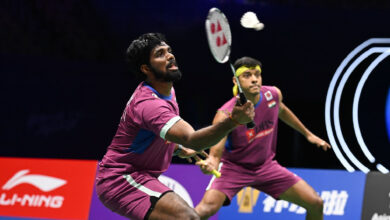Axar Patel and Ravi Bishnoi set up game before Arshdeep Singh bowls India to victory over Australia | Cricket News

From being the most expensive bowler on the night, Arshdeep Singh became the last-over action hero to steal a memorable he for his team at the Chinnaswamy Stadium. Just 10 runs, a rampaging Matthew Wade on strike, and a profligate seamer to defend those runs; India seemed resigned to the fate of an eventual defeat before the left-arm seamer did the unexpected star turn and nailed the Australian captain with the third ball to effectively seal the match, which they edged with a six-run margin to wrap up the series 4-1.Arshdeep’s three previous overs had bled 37 runs, a continuation of a troubled series wherein he had looked both out of rhythm and out of ideas. He has leaked 10.38 runs an over while nabbing just four wickets in as many games. But the last over would probably provide a timely upshot of confidence to put up a legitimate case for being included in the T20 World Cup squad.
In a way, the sole purpose of the series was to audition players for the global event just six months away. Some were returning from injuries, some from bad form, some tested just to see if they bring something more than the first-choice players. In this regard, India’s selectors would be reasonably satisfied with how some of the youngsters and the injury-returnees have performed. The value of Yashasvi Jaiswal only zoomed and soared. An attack-minded left-handed batsman at the top is a dimension India had lacked in their pursuit of landing a T20 World Cup since its inaugural edition. His opening partner Ruturaj Gaikwad too presented a strong case, as did middle-order batsman Rinku Singh, with his carefree hitting as well as lively fielding. The catch of Ben McDermott, running towards his right and keeping his cool near the fence, was a perfect instance of the value he brings in the field.
But it would be Axar Patel’s performance that would please the selectors the most. A vital figure across formats, he endured the agony of missing the 50-over World Cup due to an injury. He was almost the forgotten one as India kept crushing opponents before crashing in the final. Given the amnesic impulses of the audience, it was important that he delivered with bat and ball in the series. Even more so with leg-spinner Ravi Bishnoi also striving for a spot.
The latter would finish as the highest wicket-taker (9) and player of the series, but Axar came second (six), and conceded only 6.20 runs an over, as opposed to Bishnoi’s 8.20. On Sunday, the left-arm spinner reiterated his value with the bat too.
On an unusually spinner-friendly surface, his 31 off 21 balls was perhaps more valuable than his splendid bowling analysis of 4-0-14-1. Axar has a languid and compact technique, a good reach and a fluid bat-swing, whether he chooses the horizontal or vertical bat. He also has an ice-cool composure to sense the drift of the game.
He strode out to the crease with the team in strife at 97 for five in 13.1 overs. Conventional wisdom would have suggested him to hang around and give most of the strike to the established Shreyas Iyer. But the latter was struggling to time the ball, partly due to the turn that was on offer and partly due to the resourcefulness of Australia’s bowlers. So once Axar got set, he counterattacked. A slash off Jason Behrendorff showed fast hands scorching the wide ball towards the rope. Nathan Ellis was thumped over extra cover, before he swung Behrendorff, the big bustling left-armer, over long-on with the crispness of a toasted slice of bread. Axar’s knock, thus, gave India the impetus to reach 160, which was more competitive than a comprehensive total.
He would make a stirring impact with the ball too, but that is a certainty on surfaces that offer even a modicum of turn. Bishnoi had just expelled Travis Head, when skipper Suryakumar Yadav introduced Axar to pile on the pressure and create doubts in the mind of the batsmen. All he took was one ball to sow suspicion in their heads. The first ball whizzed across the bat of Aaron Hardie. It’s a siner sign when he turns the balls massively, and Australia’s batsmen would duel him with fear in their eyes. He would slip in the straighter one, and then the slider to make the track resemble a batting hell. That he had to wait till his 20th ball of the day for a wicket is still a mystery, but the wicket of Tim David was important in the context of the game, as he was looking increasingly comfortable. Had his partnership with Ben McDermott flourished, the match would not have turned out to be the thriller it eventually was.
Pitch a spinners’ friend
How the match ebbed and flowed owed to the nature of the pitch too. This was not the usual Chinnaswamy shirtfront. The first sign of how the pitch would behave came when leg-spinner Tanveer Sangha caught the leading edge of Iyer’s bat with a devilish leg-break. The ball drifted in, landed on leg-stump, and spat away. Not anticipating the turn, Iyer had already closed the face of the bat to work the ball leg-side. Fortunately for him, the edge fell safely. Thereafter, Iyer employed caution, which he rarely extends to spinners. The risk-taking was left to Jitesh Sharma, who dispatched Sangha for a four and a six, though the latter came off a misjudged catch in the deep Behrendorff, who ended up pushing the ball beyond the rope. Whenever Sangha imparted revolutions on the ball and tossed them up, he purchased eye-popping turn.
That Australia had no other spinner relieved India, though the medium pacers probed suffocating lengths and rarely fed the room for free swings. They harnessed the extra bounce and carry the surface offered, constantly shuffling between short and hard lengths. Three of India’s top six —Jaiswal, Surya and Rinku – perished either to short or back-of-length balls.But essentially, the spinners would deal the decisive blows, while a hitherto off-colour seamer would pick the last over of the series to dazzle.







